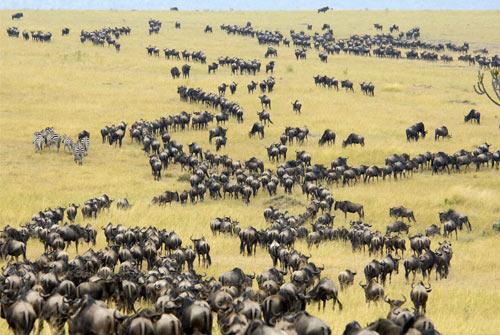
Products for NIMBioS Working Group:
Habitat for Migratory Species
Publications
- Bieri JA et al. 2018. A guide to calculating habitat‐quality metrics to inform conservation of highly mobile species. Natural Resource Modeling 31(1): e12156. [Online]
- Earl et al. 2017. Quantitative tools for implementing the new significant portion of the range definition for the Endangered Species Act. Conservation Biology. [Online]
- Erickson RA et. al. 2017. Defining and classifying migratory habitats as sources and sinks: The migratory pathway approach. Journal of Applied Ecology. doi.10.1111/1365-2664.12952 [Online]
- Nicol et al. 2016. A management-oriented framework for selecting metrics used to assess habitat- and path-specific quality in spatially structured populations. Ecological Indicators 69:792–802.
- Sample C et al. 2019. Quantifying source and sink habitats and pathways in spatially structured populations: A generalized modelling approach. Ecological Modelling 407:108715. [Online]
- Sample et al. 2018. A general modeling framework for describing spatio-temporal population dynamics. Ecology and Evolution 8:493–508. 10.1002/ece3.3685
- Wiederholt et al. 2018. Estimating the per-capita contribution of habitats and pathways in a migratory network. Ecography. [Online]
Presentations
- Sample, C. January 2016. A fundamental modeling framework for spatio-temporal population dynamics. Special session on Mathematics in Natural Resource Modeling, Joint Mathematics Meetings, Seattle, WA.
- Long K, Bieri JA, Dissanayake C, Erickson R, Thogmartin WE. January 2015. A continuous energy-based model for the migration of species in a network. Joint Mathematics Meeting, Seattle, WA.
- Wiederholt R. January 2015. Estimating the contributions of discrete habitats in population dynamics of migratory species. Joint Mathematical Meetings, San Antonio, TX.
NIMBioS
1122 Volunteer Blvd., Suite 106
University of Tennessee
Knoxville,
TN 37996-3410
PH: (865) 974-9334
FAX: (865) 974-9461
Contact NIMBioS
From 2008 until early 2021, NIMBioS was supported by the
National Science Foundation
through NSF Award #DBI-1300426, with additional support from
The University of Tennessee, Knoxville. Any opinions, findings, and conclusions or recommendations expressed in this material are those of the author(s) and do not necessarily reflect the views of the National Science Foundation.
©2008-2021 National Institute for Mathematical and Biological Synthesis. All rights reserved.


